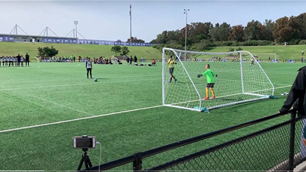The best advertisement for our game is a product not enough viewers get to see.
Let me begin by saying that I’m not a fan of the federal government’s anti-siphoning list. Call me naïve, but I like to believe those that govern us have more pressing matters than determining which sports should or shouldn’t be shown on free to air television – the economy, environment, human rights, healthcare, national defence, take your pick.
Nonpartisan political idealism aside though, as I see it the broadcast agreement for any sport is a commercial concern, not a cultural one as the list’s compilers would have us believe.
As such, any sport’s governing body should be free to select broadcast partners in accordance with their own marketing strategy, absent from what amounts to anti-competitive government interference, and always in their own commercial best interest.
Of course this begs the question, what is precisely in the best interest of a particular sport? And, more pertinent to this blog, what is in the A-League’s best interest?
Ultimately, it comes down to how established a particular sports brand is.
A mature brand with long-standing relationships with its consumers, such as the AFL, NRL or even the English Football League, has the luxury of seeking the highest revenues on offer, certain in the knowledge their faithful fan base will follow the broadcast wherever it may go, including subscribing to pay-television or internet services if need be.
Conversely, an immature, still developing brand like the A-League must place a premium on exposure rather than revenue as part of its growth strategy. It needs to ensure as many people can view its product as possible; a ‘try before you buy’/’spend money to make money’ hybrid approach that seeks to convert the curious into consumers based upon the quality of the product.
And, in my opinion, there’s no higher quality of product in the A-League than the season’s showpiece event - the grand final. It has drama, prestige, and most importantly when it comes to promoting our game to non-football people, a guaranteed result.
However, exposure for this match, like every grand final before it, will once again be limited to those with match day tickets and those with access to FoxSports. It’s a situation that, regardless of the terms of the broadcast deal, simply should not be.
This doesn’t necessarily mean that the anti-siphoning list, with its one-dimensional free-to-air broadcast requirements, is the solution though. In my opinion, the benefits provided by comprehensive live coverage of all regular season games by FoxSports still outweighs the delayed-for-advertising, match-of-the-week type coverage that the commercial stations can offer.
However, the current broadcast deal need not see the league hamstrung either. It just requires thinking outside the box – the idiot box that is.
Regrettably, one of the more obvious options has once again been overlooked. For the second year in a row the A-League grand final will not have a public viewing area – a FIFA-esque fan site for those unable to obtain tickets to the sold-out stadium.
When asked, Brisbane Roar cited the costs of staging such an event as being prohibitive and, in the opinion of your humble blogger, this is entirely reasonable. However, it is also my opinion that the cost of staging a fan site need not, and should not, be borne by the club; especially since the club makes little-to-no money from the grand final anyway.
You see, the ticket revenue from this once a year bonanza goes directly to Football Federation Australia as owner-operators of the A-League Finals series; and, as such, the onus must fall on them to reinvest it to ensure maximum exposure and maximum benefit for the game as a whole.
By establishing an official fan site – ie placing a giant screen in a public space, preferably somewhere grassy and inviting to families priced out of the match venue [eg in Perth as well as Brisbane, perhaps? - KA] – the A-League grand final can become more than just a football match, it can become a key component in the community engagement activities the sport is still crying out for at the elite level.
This sideshow to the main event, with the right promotional techniques, could be used to leverage not only the brand of the federation and club, but also the brand of the broadcaster and other sponsors.
Simply set up some information stands promoting the sponsors’ products, hand out some balloons, sizzle some sausages, paint some faces and, voila, instant family-friendly fan site for those unable to attend the match.
Such an approach ensures greater exposure and serves to build bankable goodwill for not only the A-League, but for Foxtel and the other sponsors too. Further, with so many brands on board, it becomes possible to somewhat share the cost burden as well.
All of a sudden it becomes not merely a case of using a broadcast deal to increase football’s exposure; but football capitalising on community interest to provide something back to the broadcast partner. It’s a complementary, multi-dimensional, value-adding approach that provides more than a simple free-to-air deal can on its own.
Many will disagree, but I fervently believe the FFA cannot afford to lose the benefits its exclusive deal with FoxSports brings in the short term, but, with further review of the anti-siphoning list years away, it doesn’t mean it can simply ignore the need to extend its reach.
If the “we are football” mantra is to have any viability beyond a mere slogan, then the league’s showpiece event must be as accessible to as many potential football fans as possible, especially in its host city.
The on-field success of a championship club can’t last forever, hence capitalising on a grand final, when community interest is at its zenith, is essential to ensuring the continuing viability of not only the club but the league as well.
This need not include free-to-air television coverage, but it does require a vision that lets it be known to the whole city, not just those with match tickets or a FoxSports subscription, that they can be part of football too.
Related Articles

Fresh talent flock to ambitious A-League outfit's pro pathway

Why A-League 20/21 is crucial for Olyroos’ medal hopes













